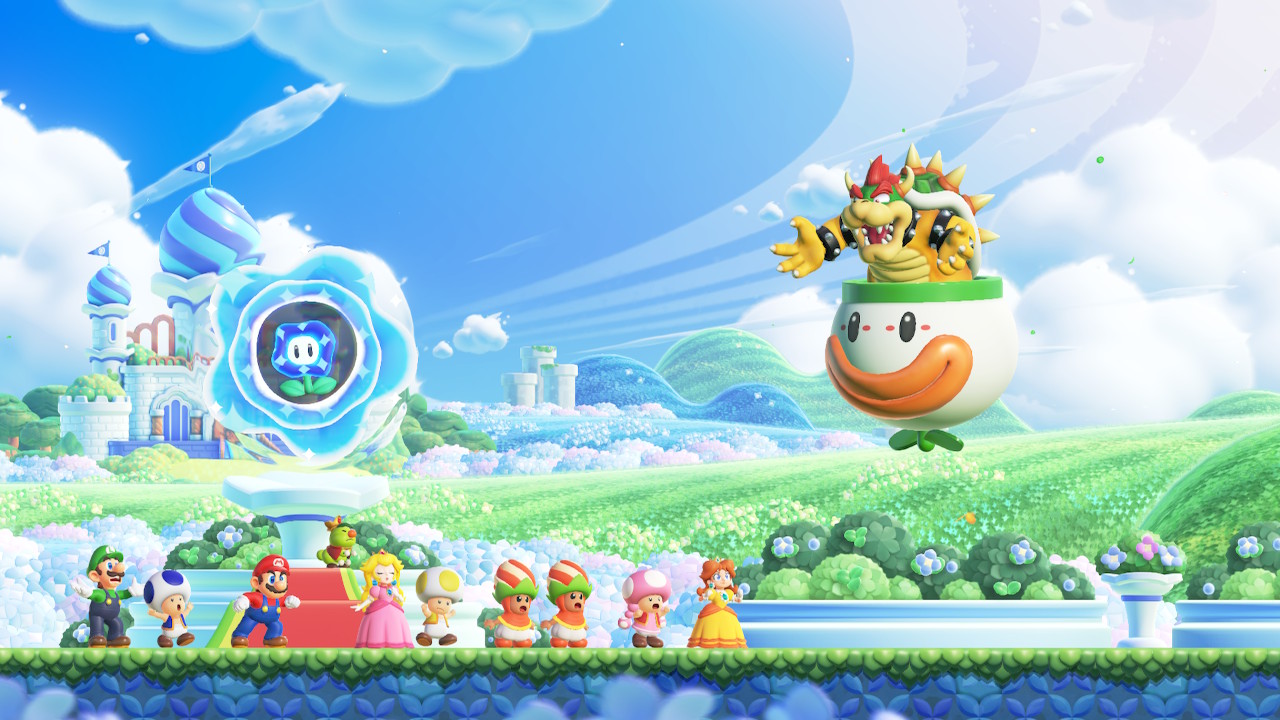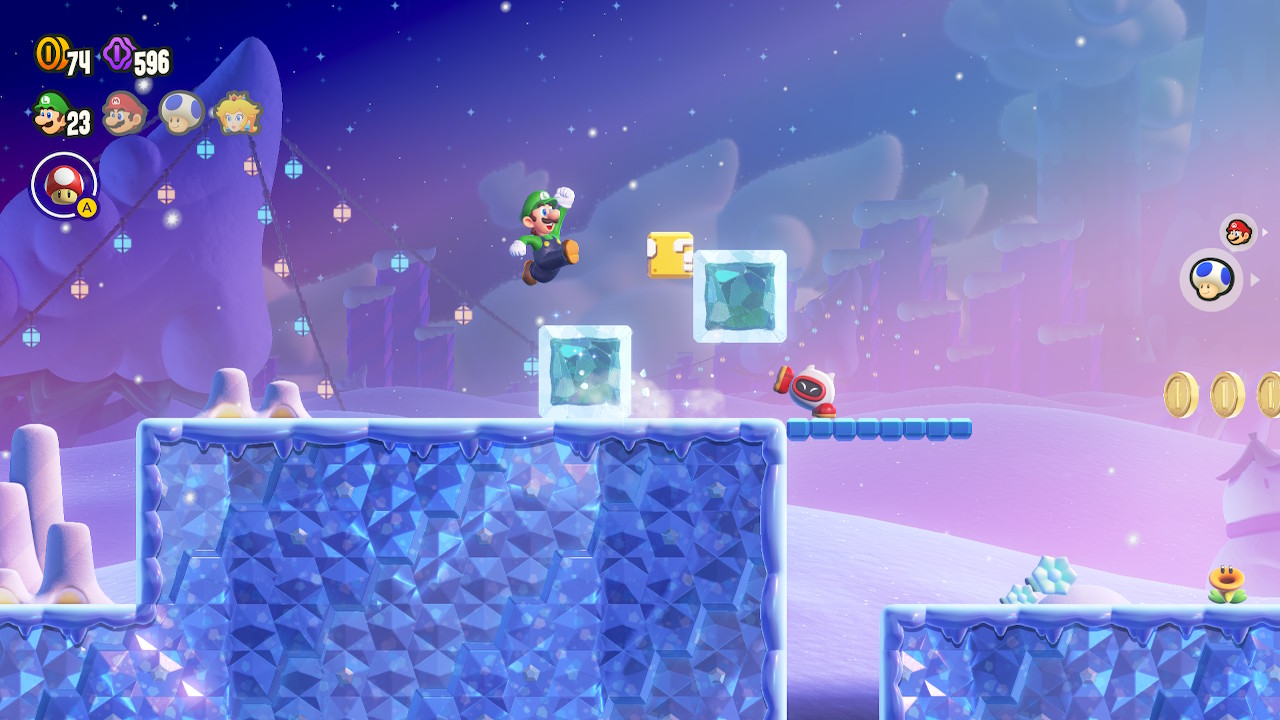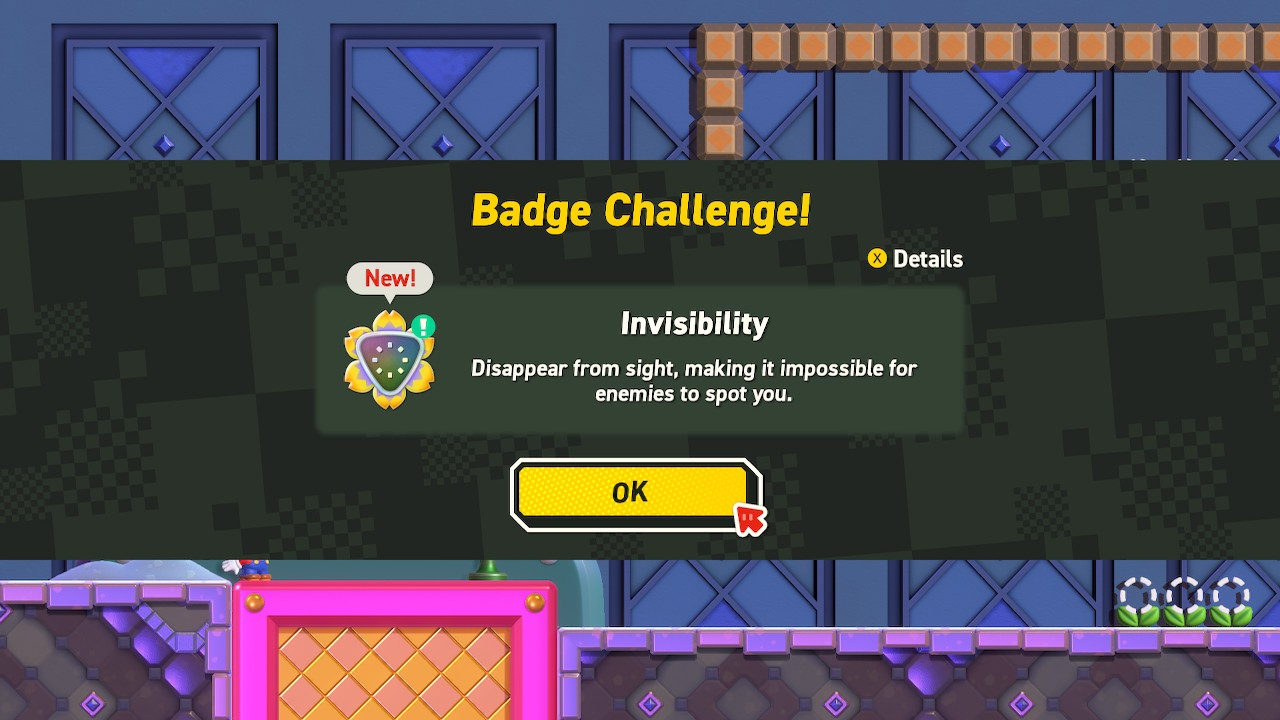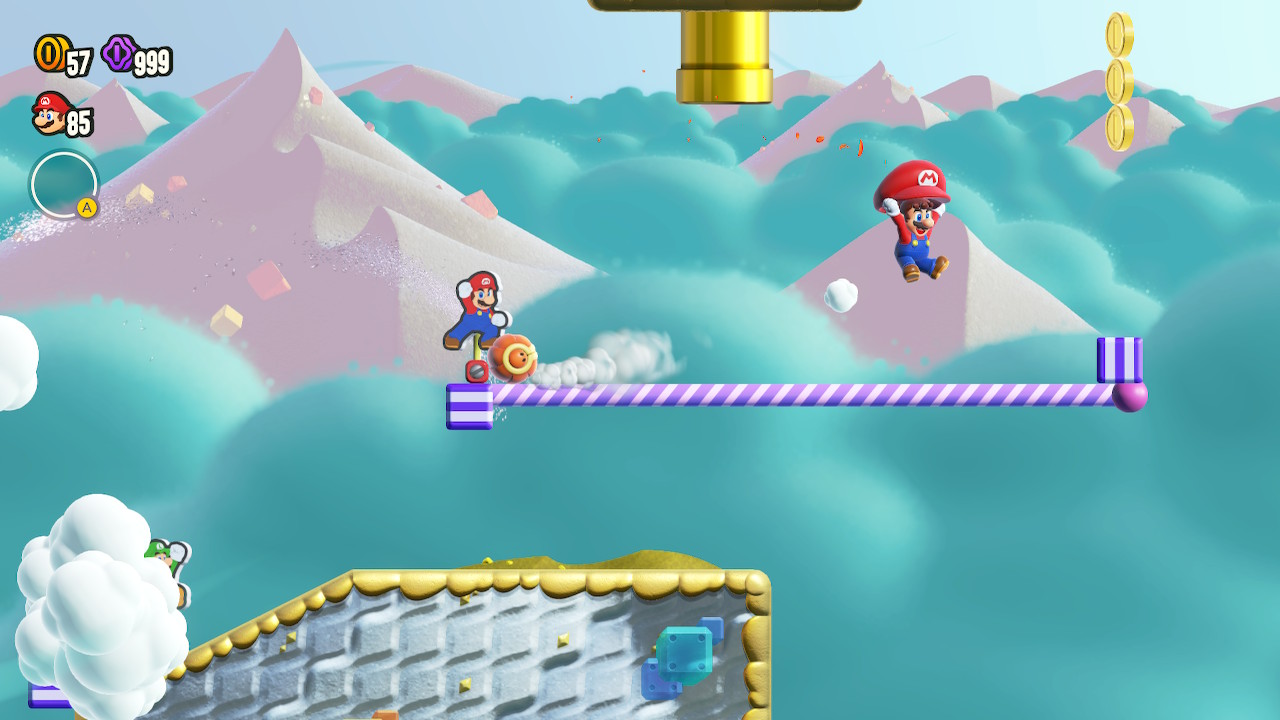System: Switch
Release date: October 20, 2023
Developer: Nintendo
Publisher: Nintendo
As I reflect on my time spent with Super Mario Bros. Wonder, there truly wasn’t a single moment when I wasn’t having an absolute blast. Any time it seemed impossible that there could possibly be any other surprises left in a game that already had been bombarding me with creative ideas left and right, to my delight, I was always proven wrong. At its core, Super Mario Bros. Wonder is the same joyful platforming adventure that Nintendo has crafted for decades. The key difference this time is that the developers have designed a fundamental sense of novelty into every stage, every new mechanic, every visual flourish. The result is a side-scroller that always feels fresh, fun and exciting in ways that few genre peers have accomplished.
Super Mario Bros. Wonder is the first core 2D Mario title to drop the “New” prefix that was central to the series’ branding since 2006’s New Super Mario Bros. That’s a strong statement in of itself, setting an expectation that players are in for something different this time around. There’s an increasingly popular sentiment online that, in retrospect, the “New” era of the series’ history didn’t really move the innovation needle forward substantially over the course of those games lifespans. That’s not to diminish the overall quality of games like New Super Mario Bros. U, which is very high, but rather it reflects the hunger Mario fans had by mid-2013 for something truly original. It may have taken longer than expected, but Super Mario Bros. Wonder feels like a direct response to that notion, and in that regard it’s a marvelous accomplishment.

For starters, we’re not in the Mushroom Kingdom anymore; this time around, Mario and crew are in the neighboring Flower Kingdom, and the developers used that simple change as creative leeway to get weird. I mean, for one thing, there are now talking flowers spread around each stage who provide words of motivation and act as companions on your journey. Considering how light 2D Mario games usually are in voiced dialogue, that’s a huge change that could have been somewhat of a risk, but I genuinely grew to love the little fellas. After a brief introduction introduces the other residents of the Flower Kingdom, including their adorable leader Prince Florian, Bowser uses the mysterious powers of this new kingdom to somehow transform into a giant, anthropomorphic, sentient floating castle. That’s also pretty weird, even for Bowser!
He sets up shop in the center of the Petal Isles, which serves as the overworld that connects the various regions of the game in a structure similar to the classic Super Mario World. From here, players will set out across six worlds – excluding the Petal Islands themselves, and a special world with extra challenges – to collect enough Wonder Seeds to lower Bowser’s defenses and enter his domain. Yes, the biomes that stages exist in are familiar – you’ve got your grassy world, your desert world, your underground world, et cetera – but beyond that cursory level, almost everything is different.

Perhaps the most immediately striking element of Super Mario Bros. Wonder is its new art direction, which is strongly driven by incredibly lively animations that raise the bar for the genre. Mario no longer simply slides out of a Warp Pipe – he wiggle his legs and pushes himself out. When he crouches, he grabs the brim of his hat and pulls it over his eyes, He’s angled a bit more towards the player, so he expresses his emotions on his face more than ever before. Our cast of heroes almost look like action figures that have sprung to life, and it’s truly stunning to watch in motion.
There are new enemies abound in Super Mario Bros. Wonder, and most of them add new mechanical considerations to the act of navigating a stage. Blewbirds, for example, shoot platforms out of their beaks that stick to walls, giving Mario additional surfaces to jump from. Hoppos are rotund hippo-esque creatures that roll into pits and act as springboards to jump from, and Maw-Maws will chase after and try to swallow any creatures that cross their paths. These are only a handful of the new additions, and many of them only appear in a few stages at most, but that in of itself is a big reason why they always felt so exciting to encounter.
There are new types of stages, too, beyond just the traditional “reach the goal” format that epitomizes 2D Mario. My favorite were the new KO Arenas, which task the player with speeding through a gauntlet of enemies and clearing them out as rapidly as possible to reap higher rewards. I also enjoyed the new Search Party stages, which task players with exploring small but dense open spaces to uncover the hiding places of the five Wonder Tokens hidden throughout the course. Some returning ideas, like auto-scrolling airship stages and races against NPCs, help shake up the pace further. While a lot of these stages are optional for players trying to beeline their way to the final boss, they were some of the highlights of the game for me, partially because of their somewhat higher difficulties.

Another new type of stage called Badge Challenges gives players room to experiment with Badges, which represent Super Mario Bros. Wonder’s biggest overall shakeup in moment-to-moment traversal. These are equippable modifiers that tweak aspects of how Mario and friends move in any level in the game; they do things like let players glide in mid-air, jump higher and further, swim faster (with a nostalgic shake of the Joy-Con controllers), or fall into a bottomless pit without penalty. At first, I wasn’t convinced that Badges would feel powerful enough to encourage me to want to use them, but there’s a convincing element of added strategy to using them well that encourages efficient course playthroughs. While most of them can act as somewhat of an accessibility feature, there are also Expert Badges that aim to make the experience more difficult, like making it so Mario can never stop sprinting or jumping once he starts. Even those ones still were fun to use, although I generally avoided them outside of their associated Badge Challenges for the sake of my own sanity.
All of that is exciting, but it was really the Wonder Flowers that consistently made my jaw drop during my playthrough. These special power-ups exist in every main course in the game, and when collected, completely change the stage into something weird and exciting, and rarely do they repeat their own ideas. Perhaps a Wonder Flower will turn you into a Goomba, thus requiring you to stealthily sneak through foliage to avoid being sighted by Maw-Maws who would like to make you their lunch. Maybe you’ll be sent into space, or be able to swim through lava, or perhaps a full-fledged musical number will break out around you. Whenever you pick up a Wonder Flower for the first time, you truly never know what will happen, and that results in a game that consistently feels fresh.

I’ll concede that it can, at times, be a bit overwhelming being exposed to such high-energy antics so constantly; it’s somewhat of a dopamine overload compared to previous games. Super Mario Bros. Wonder doesn’t give the player many opportunities to sit back, breathe, and appreciate some straightforward platforming without all the frills of its new mechanics. Pardon the strange metaphor, but it’s a bit like eating a box of Jelly Belly jellybeans; each one tastes good, and there’s a little bit of surprise when you taste a new flavor, but eventually you are tasting so many new flavors that they begin to lose their individual impact. It’s not really a big issue, by any means; again, there’s very little to fault at the mechanical and creative level, and I had fun with each Wonder Flower I encountered. But part of me wonders if the Wonder Flowers would feel a bit more special if they were more sparsely spread out across the runtime of the game, rather than being a vital component of every stage.
Fortunately, there’s still a ton of replayability in Super Mario Bros Wonder, especially the for those trying to 100% the game. Between collecting the three purple flower coins hidden across each level, hunting for secret exits, and of course the Wonder Flowers themselves, there are plenty of things to discover when revisiting stages. Some secret levels exist too that are pretty well hidden, including a few deviously difficult challenges that demand incredibly precise platforming. I get the sense that speedrunners and streamers will get a lot of mileage out of those aforementioned Expert Badges too, which seem perfect for placing self-imposed challenges. Heck, the music in Super Mario Bros. Wonder is so delightful that I replayed some stages just to hear certain tracks again!

That’s a good representation of how all the little additions and tweaks to Super Mario Bros. Wonder somehow manage to feel just as meaningful as the big ones. The World Map is more open than ever, and is dense with tucked-away secrets for those willing to seek them out, and I love the fact that levels don’t have to be played in a locked-down order. The new power-ups, while not game-changing, are plenty of fun – there’s nothing like watching Daisy, one of the new playable characters, transform into a giant elephant and stampede through a brick wall, or like watching a Toad drill through the ceiling as a literal drill.
One final aspect of Super Mario Bros. Wonder that I enjoyed significantly more than I had expected was the game’s new approach to online multiplayer. As someone who generally isn’t attracted to online play, I was a bit hesitant about the idea of having other players present while I’m trying to make my way through a stage, and was worried it might be a distraction at best. It’s a bit different than what I expected, though, in that while I could see others jumping through a stage alongside me as I made my way through, everyone’s progress is independent from one another, and there’s very little direct interaction. You don’t have to worry about another player bumping into you and pushing you off a cliff, either, as there’s no collision between players. Interestingly, online multiplayer functions as more of a passive experience, one based around gentle cooperative interactions. You can place little cutouts of your character around the level to act as checkpoints for other players in case they die, for example, or you can give an extra powerup to a player in need. You can, by watching the ghosts of other players, often discern where hidden platforms and passages might be. You can even revive other players by running over to them before a countdown clock expires. These are all little interactions, but they help create a sense of togetherness and mutual support that I found really wholesome and delightful. And of course, local couch play is still present if that’s more of your jam, too.
The Verdict

By the time I rolled credits on Super Mario Bros. Wonder, I felt like I had woken up from a dream. This game is just so impeccably polished, joyful, and fun that it doesn’t feel like it should be real. In an era dominated by unfinished, bloaty, buggy games that are demanding more of players’ patience than ever before, Super Mario Bros. Wonder is a delightfully refreshing game that feels genuinely crafted with love. It raises the bar for what a Mario game can be, and is one of the best platformers I’ve ever played.
Super Mario Bros. Wonder copy provided by the publisher for the purposes of this review.